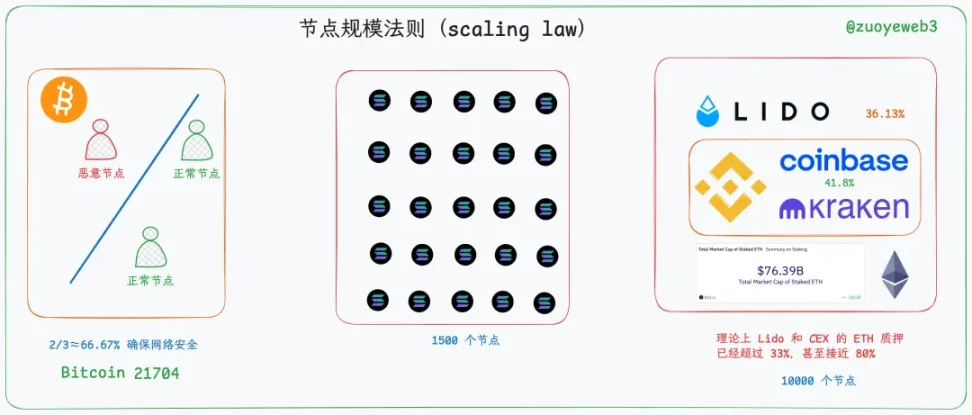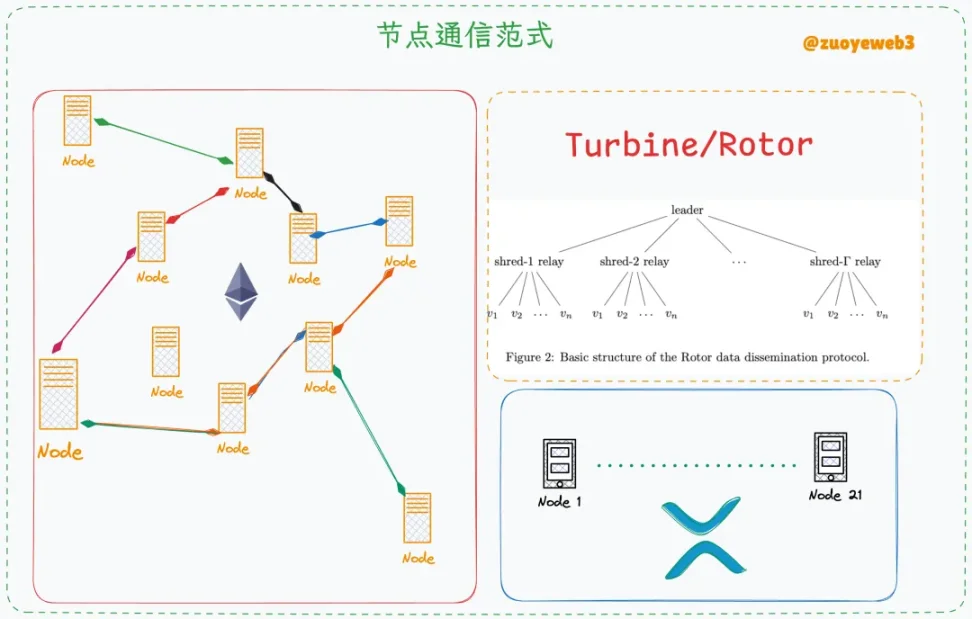Ethereum returns to the L1 narrative, and Solana consensus accelerates
Author: Zuoye
Ethereum began supply-side reform.
After the dream of the Infinity Garden was shattered, Vitalik constrained the L2/Rollup human debt and defended the L1 track with a more active attitude, and the Ethereum mainnet "speed increase and fee reduction" plan was put on the agenda, and the switch to Risc-V was just the beginning, and how to catch up with or even surpass Solana in efficiency will become the next highlight.
Solana continues to expand consumer demand scenarios.
In addition to the Firedancer developed by Jump Trading entering the deployment process, at this Solana conference in New York, the Anza team's Alpenglow consensus protocol won the first prize and attracted the attention of the audience.
Ethereum's ultimate dream is a world computer, and so is Alpenglow.
The 20% secure consensus in the era of large-scale nodes
starts with Bitcoin, where the number of nodes and dispersion are synonymous with the degree of decentralization of the blockchain network, and in order to avoid centralization, the security threshold is limited to 33%, which no entity should exceed.
Boosted by capital efficiency, Bitcoin mining eventually moved to mining pool clusters, and Ethereum became the main stage for Lido and CEXs, of course, this does not mean that mining pools and Lido can control the operation of the network, and they have no evil motive in the "maintain the network - earn incentives/management fees" model.

Caption: The Law of Blockchain Node Scale, Image Source: @zuoyeweb3
However, the health of a network must be measured by its size, for example, in a small group of 3 people, 2/3 can be called effective operation, it makes no sense to pursue only any 1/3 of the minimum security, and the remaining two are very easy to connect in series, and the cost of evil is extremely low, The benefits of evil are enormous.
If it is a large-scale network of 10,000, if Etherscan gives the size of Ethereum's existing nodes, there is no need to pursue a 2/3 majority vote, and outside the incentive model, most nodes do not know each other, and the cost of coordination between Lido and Binance is too large.
If we reduce the number of nodes and the consensus ratio a little, can we "speed up and reduce fees"?
As you can imagine, Alpenglow thinks the same way, and is prepared to do so, maintaining Solana's 1,500 nodes while reducing the security consensus to 20%, which can not only improve the speed of node confirmation, earn more mainnet incentives for nodes, but also encourage the expansion of node size, such as swelling to around 10,000.
Whether it's a 1+1>2 effect or a breakdown of existing security mechanisms can happen.
However, I like it very much, Solana should take the route of the American chain, the cabal, and the centralization, and participate in the public chain competition as the opposite of Ethereum.
The theoretical idea ofTurbine, or towards DPoS
Alpenglow, is that the number of consensus in the era of large-scale nodes does not need to be too strong, because of the PoS mechanism, the evildoer needs to mobilize a huge amount of capital to control, even if it is 20% of the scale, at the current price, Ethereum needs $20 billion, and Solana also needs $10 billion.
With $10 billion, it's not good to do something, it's crazy to control the blockchain, and it's going to be countered by the remaining 80% of nodes, unless it's a state action.
In practice, Alpenglow roughly divides the entire process into three parts: Rotor, Votor, and Repair (refer to his paper for more detailed division and workflow), and to some extent, Alpenglow is a deep transformation of the Turbine mechanism, so we briefly introduce Turbine.

Caption: Block Broadcast Mechanism, Image Source: @zuoyeweb3
Turbine is Solana's Block Propagation mechanism, which is simply a messenger that propagates block information to reach consensus confirmation by all nodes.
In the early design of Ethereum, block broadcasting is the Gossip protocol, the Chinese name is like "rumors, gossip", any node can be used as the initial messenger, and any node can carry out P2P communication, and finally achieve the effect of the whole network confirmation, just like "I have a message, I only tell you, you must not tell anyone", and eventually the world will know.
Let's skip Turbine for the moment and use Ripple's DPOS mechanism to make a comparison, Ethereum/Bitcoin has achieved the ultimate peer-to-peer communication, so what is the cost?
It is extremely slow and expensive, which is also very understandable, the aimless, random pairing between nodes, although it will be more Robust and more censorship-resistant, but it will take longer, and expensive is the consideration of node cost, because other nodes have slow information transmission and want to maintain their own operation, so it will naturally be passed on to users in the form of gas fees.
Extreme decentralization will inevitably bring expensive and slow companion illness.
Ripple's DPOS went to the other extreme, with only 21 supernodes on the entire network at the beginning, and extreme centralization completely solved any side effects, and now the number of mainnet nodes has reached 179.
Turbine, on the other hand, is moving towards an intermediate state, neither using Ethereum's Gossip mechanism nor going to the evil path of reducing the number of nodes, but spreads the network nodes in stages:
1. In each epoch, nodes are divided into Leader, Relay, and more ordinary nodes, and only Leader nodes can send block broadcast information
2. A small number of relay nodes receive information and continue to broadcast to more ordinary nodes, the above process is called Turbine Tree, much like a tree, with clear priorities.
In Alpenglow, a variant of the protocol is called Rotor, which essentially propagates block messages in an orderly manner, and any leader and relay node is not fixed.
For example, in Alpenglow's vision, the first round of node voting reaches 80%, and if the minimum of more than 20% is met, it can be directly and quickly passed, and if the first round of voting is higher than 60% and lower than 80%, the second round of voting can be opened, and the final confirmation can be exceeded by 60% again.
If it doesn't work, then go through the Repair mechanism, but I personally feel that this is similar to the challenge period of the Optimistic Rollup, and if it really comes to this point, there is a high probability that the agreement will be over, and the FDIC will not be able to stop the run on Silicon Valley Bank.
Unlike brute-force heaps, where hardware and software resources increase bandwidth, Alpenglow's starting point is to reduce the block consensus generation process.
If the data block is as small as possible, such as limited to about 1500 bytes at present, the generation time is short enough, for example, in the current test, the limit case can run to 100ms, which is 1% of the current 10s. (1 s = 1000 ms, but this is doubtful, it is really practical on a large scale, the conditions will not be so ideal, but it is also terrifying).
ConclusionAfter
MegaETH, the existing L2 basic volume to the end, after SVM L2 will not be supported by Solana, the Solana mainnet has a real demand for continued expansion, and only the mainnet TPS overrides all competition to implement the concept of Solana's Ethereum killer to the end.
Alpenglow is not limited to Solana, theoretically, any PoS chain, including Ethereum, can use its mechanism, and similar to Optimum we introduced earlier, the existing blockchain research has gone to the edge of technology, and more computer science and even sociological ideas are urgently needed.
IBM once claimed that the world would only need five mainframes in the future, and if the HTTP-TCP/IP Internet was one, BTC was one, and Ethereum was one, there would not be much room for Solana.
